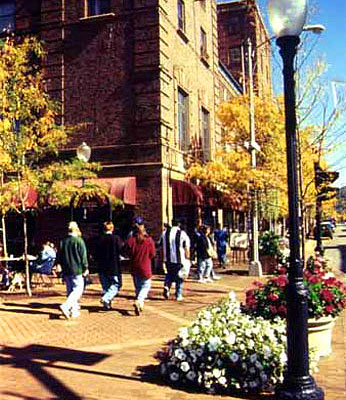Origins of the Main Street program
 Market Street, Corning, New York. The "first" Main Street program?
Market Street, Corning, New York. The "first" Main Street program?This year is the 25th anniversary of the formal, national Main Street program, and at last week's Main Street conference, recognizing this was a big part of the program, including the Closing Plenary session, which featured reminisences from the "founders" of the Main Street program, Mary Means, the director of the Midwest Regional Office of the National Trust for Historic Preservation, and Scott Gerloff (Hot Springs, South Dakota), Tom Moriarity (Madison, Indiana), and Clark Schoettle (Galesburg, Illinois), who were the first three Main Street managers.
Each of the three managers had an expertise that ended up becoming the foundation of three of the four Main Street points: organization; promotion; and design. "Economic restructuring," which each of the three managers claim credit for coining, came about once they moved to the National Trust's office in Washington, DC in 1980, to create what became the National Main Street Center, and they had to figure out how to get funding to maintain and extend the program.
When queried by people in the field of "economic development" the Main Streeters realized that the other parts of what they had been doing in the field, but that didn't fit into the three points, was really restructuring the economic model of the town's commercial district. (The three years of the demonstration project, 1977-1980, pre-dated the founding of the national program. We also learned that 65 communtiies applied to be selected as one of the three pilot sites.) ER ties the "economic development" aspects of the Main Street approach into the fourth point.
At the opening session, Doug Loescher, director of the National Main Street Center, gave a presentation that included snippets of the "Main Street Movie," which was produced as part of the original demonstration project in the midwest. (I want to see that movie, even though it's dated...)
The movie featured selections on Corning New York, and between that and a discussion in the closing, I was able to put some pieces together about various mentions I have seen here and there about Corning, New York and the Main Street program.
At times, I have seen Corning, New York referred to as the "first" Main Street program. Technically, it wasn't, but it certainly was probably the first formal commercial district revitalization program comparable to Main Street.
In 1974, the Market Street Restoration Agency hired a full-time manager, Norman Mintz, to help rebuild the community's business district, which had been decimated by strip shopping center development on the outskirts of the community.
Some people believe that this effort was in response to a devastating flood that occurred in 1972, but actually discussions about the Market Street business climate began in 1964, and one of the steps taken, cladding architecturally distinctive buildings in "more modern" materials such as ceramics or alumnimum was actually an attempt to move the district forward. When a regional mall opened in 1968, business owners responded with a facade improvement program in 1970. Rather than tear down buildings, the city used urban renewal money to install brick sidewalks and to plant Locust trees. This further encouraged business owners to restore traditional facades.
Corning is the place of one of the big examples of the impact of taking off alumnium or other out-of-character building materials in favor of the traditional architecture underneath. Unfortunately, I do not have a visual of the classic example.
At the Closing Plenary, Mary Means said that probably the most important point was having a full-time Main Street manager, as the key innovation of the Main Street program. She specifically mentioned Norman Mintz and the impact of his full-time work on revitalizing the Corning commercial district as providing the example of why this is so important.
A discussion of the Main Street program in Corning is online at www.freeholdcenter.com/history at the end of the opening document in an article "How Main Streets Turned the Corner: American's Towns and Cities Are Finding A Wonderful Life When Development Dollars Go Downtown," by Brad Edmondson. This article features extended discussion of Main Street work in Chattanooga, Tennessee and Coronado, California as well. The story of Corning and Norman Mintz's work is particularly interesting, because it was the forerunner of so much more.



0 Comments:
Post a Comment
<< Home